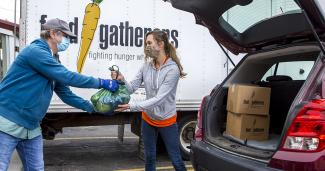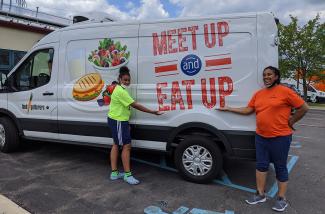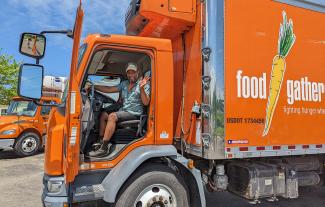More Life, Less Stuff
In partnership with the Ecology Center and the City of Ann Arbor, the More Life, Less Stuff campaign aims to inspire the community to use less stuff and connect with the world around them. This story is the first in a series highlighting and supporting people and organizations making things better in our community and our world. Learn more at a2morelife.com
The Cost of Wasting So Much Food

Every year, Americans throw away a mind-boggling 66 million tons of food. To put it into perspective, this is almost 40% of the food we produce, and a staggering 60% of this waste ends up in landfills.
Changes, even small ones, can dramatically reduce the amount of food we waste, reducing the impact on the environment and making resources available to organizations that help feed people in need.
More life, less food waste.
Every stage of our current food system creates waste, and the environmental impact is huge—from growing and grazing to production and manufacturing, from packaging to transportation, and from retailers to individuals.
Growing, producing, and transporting food is energy-, chemical-, and land-intensive. Conventional food production requires large amounts of fresh water and massive amounts of pesticides and fertilizers, which pollute and overburden the environment. Agriculture consumes half of the world's habitable land. The entire agricultural supply chain has GHG emissions associated with it. Agriculture is responsible for about one-quarter of the world's greenhouse gas emissions.
It's more than just the production and transport of food that has such a huge environmental footprint. Food waste storage and disposal uses lots of energy, some of which comes from fossil fuels, which release more toxic chemicals into the environment. This wasted food fills up landfills. As it rots, it gives off methane, a greenhouse gas (GHG), that is more than 80 times more potent than carbon dioxide. Methane is the second largest contributor to climate warming. Food waste, along with food packaging, makes up almost half of household, retail, and commercial waste.
All these GHG emissions from the agricultural supply chain and disposal of waste food are helping to drive climate change, a main cause of the extreme weather events like hurricanes and droughts.
Food Waste is a Preventable Problem - So is Food Insecurity.
Food waste presents both a problem and an opportunity. In our current linear system–the take-make-waste economy where we use natural resources to produce stuff that we don't need and eventually throw away–food waste is inevitable. A circular system focuses on reducing food waste by creating and purchasing only what we need and ensuring that extra food is shared with others (who may be experiencing food insecurity) or goes back into use by creating animal feed and compost. In a circular system, the majority of food waste is preventable.
Through supporting charitable organizations, such as Food Gatherers, we can fight food waste and make sure everyone in our community has food to eat.
Our Neighbors Struggle with Food Insecurity
According to Feeding America, in 2018, the average meal in Washtenaw County cost $3.39. By 2021, that same meal cost $4.05. At that time, almost 10% of Washtenaw County residents – more than 39,000 people – experienced food insecurity.
Because of the high cost of living, many people in Washtenaw County experiencing food insecurity don't meet the federal poverty guidelines and, therefore, don't qualify for the Supplemental Nutrition Assistance Program (SNAP) or other government assistance programs. SNAP benefits have returned to pre-COVID levels for those who do qualify, although prices have remained high. Food Gatherers and other food rescue programs work to fill the holes in the social safety net and ensure that every resident has access to healthy and nutritious food.
The Story of Food Gatherers
Thirty-six years ago, the founders of Food Gatherers were frustrated. They saw how much usable food was being thrown away and wasted, food they knew could feed hungry people. So, they decided to do something about it. They borrowed a van, filled it with surplus food from restaurants and grocery stores, and then delivered it to hot meal programs in Ann Arbor and Ypsilanti. This was the beginning of Food Gatherers, Michigan's first food rescue organization.
Today, Food Gatherers distributes the equivalent of 18,000 meals daily to 140 community partners. They aim to "alleviate hunger and eliminate its causes in our community." Along with their partners, they build community, fight food insecurity, and reduce food waste. Therefore, Food Gatherers is the first organization profiled in and celebrated by the More Life, Less Stuff campaign. We interviewed volunteers Frank and Lindsay Bateman as well as Markell Miller, director of community food programs, to learn more about their work in rescuing food and feeding those in need in their community.

Food Gatherers Rescues Food and Fights Food Insecurity
It works like this: Food Gatherers collects food donations from consumers, grocery stores, restaurants, and farms—food that would have otherwise been wasted—and redistributes it to people experiencing food insecurity. They also use government programs and individual financial donations to purchase food. This food goes to food pantries, low-income and assisted living facilities, and shelters for people experiencing homelessness.
Food Gatherers also has and works with programs for children. 12% of Washtenaw County's children struggle with food insecurity. One of their goals is to ensure that the meals that they serve and the food they provide contain balanced nutrition for their clients within the community. Food Gatherers works with organizations that introduce new fruits and vegetables to kids whose families may not be able to afford the risk of investing in food their children may or may not like. They also distribute food through schools and during summer break. When school gets out, students who qualify for free breakfast and lunch lose access to both meals. Food Gatherers steps in and fills the gap, making sure that these kids and teens are fed.
Through serving the community, Food Gatherers also builds community. Frank Bateman, a long-time volunteer, told me, "It's a close-knit organization. If you come into it, you're adopted; you're one of us. We have new friends because of our work there. Some of those are staff, and some of them are volunteers." Lindsay Bateman, another volunteer, said that through Food Gatherers, they "got to meet a lot of new and interesting people" and felt "like we were giving back to the community, not just writing a check." Food Gatherers's impact goes beyond saving the environment and feeding the community - it also improves lives.

How to Find Food
Food Gatherers makes it easy to get food. When asked about the process, Frank Bateman said, "If you're picking up food or getting dinner or lunch, nobody asks for your name or ID. You don't have to say a certain prayer. You just come in, you get in line, and you eat. That's all there is to it." Because Food Gatherers partners with various community organizations and distributes to pantries throughout the area, odds are you aren't far from a free meal or bag of groceries. Find a location close to you here: https://www.foodgatherers.org/foodresources/
We Can All Help Reduce Food Waste
The first step in reducing food waste is to be more intentional about food purchases. Small changes like meal planning and bringing a list to the grocery store can go a long way toward avoiding buying food you don't need and spending money unnecessarily. You could also designate an "Eat First" section of your refrigerator for foods that must be eaten soon to prevent spoiling.
If you find yourself with extra food, you can donate it to Food Gatherers, one of their partner pantries, or another program that provides food to folks in need. Food Gatherers is funded primarily through individual donations. More than 90% of every donation goes directly to food programs and every little bit counts.
Food Gatherers also relies heavily on its volunteers, who do everything from collecting food from restaurants and grocery stores to cooking and serving meals at the Food Gatherers’ Community Kitchen, located in the Delonis Center, which provides hot, nutritious meals for shelter residents. According to Lindsay Bateman, getting started volunteering is pretty simple: "It's easy to go to the website and see all the volunteer effort opportunities right there."
When asked how community members with less time or money could contribute, Markell Miller, director of community food programs at Food Gatherers, said, "We also love to encourage people to do word-of-mouth outreach, making sure people know that there are resources for them." Anyone who needs help should know where to go to find either a hot meal or free groceries. You can also follow them on social media by searching Food Gatherers on Facebook or @foodgatherers Instagram or X (formerly known as Twitter) to learn more about their programs.
A big thank you to Frank and Lindsay Bateman, and Markell Miller.

